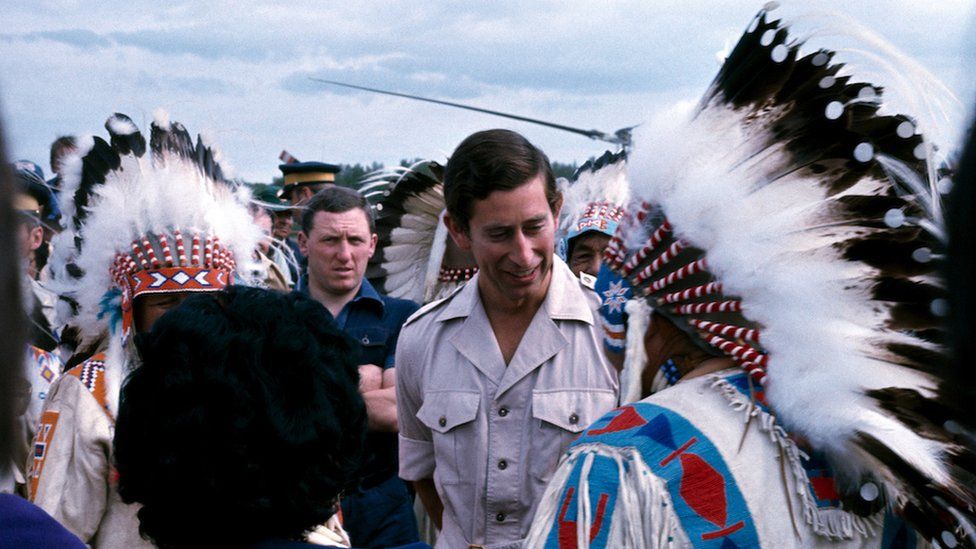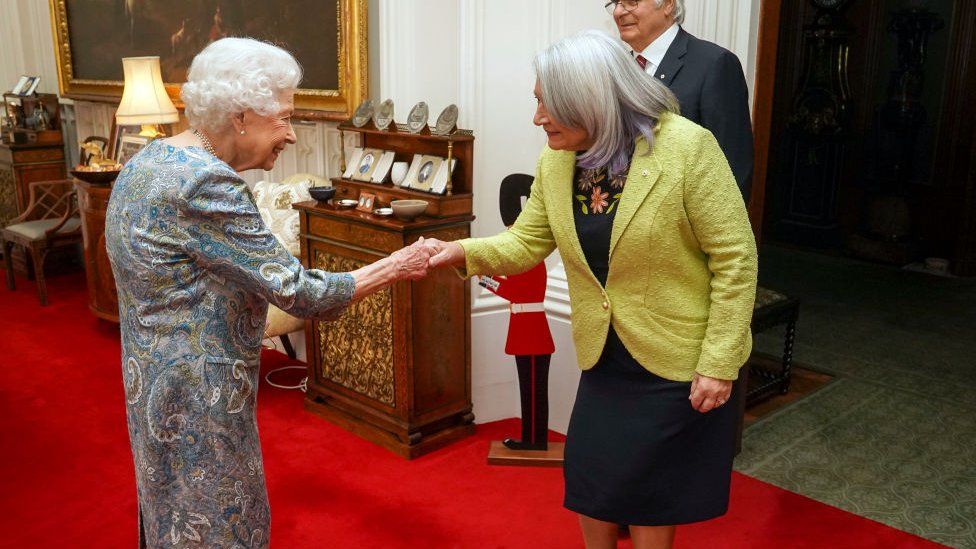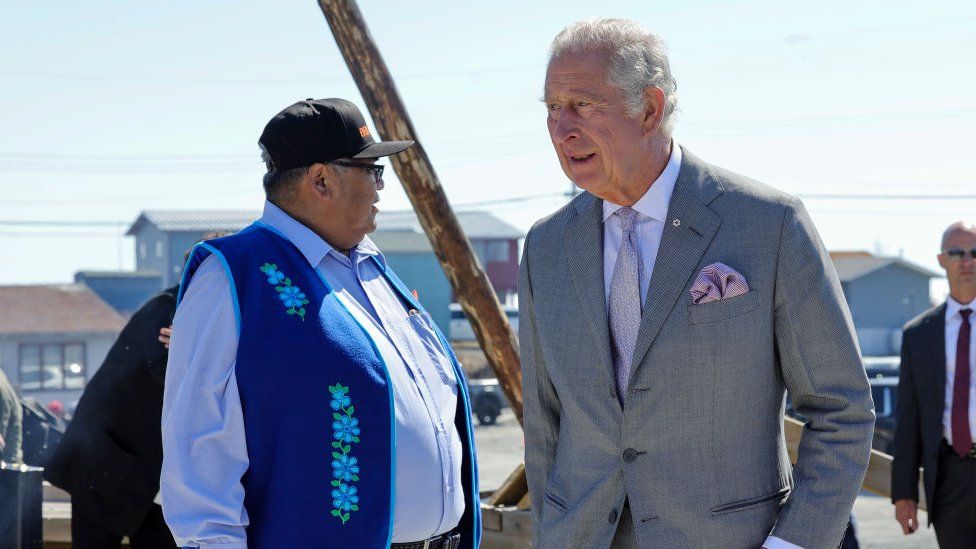By -Jessica Murphy
BBC News, Toronto
Edited by- Amal Udawatta,
In recent years Canada has worked to advance reconciliation with indigenous people in the country. What does the accession of a new King of Canada mean for that process?
Earlier this year, at a reception in Canada's national capital, King Charles - at the time the Prince of Wales - was asked for an apology.
The request came from Assembly of First Nations National Chief RoseAnne Archibald, who told him that the Crown needs to make amends for the "assimilation and genocide" of indigenous schoolchildren at residential schools run by the Anglican Church - of which Charles is now the head - and for its role in colonisation.
The three-day visit was Charles's nineteenth official tour in the country, and his last as the Prince of Wales.
Charles did not apologise on the trip, though he spoke of the need to "come to terms with the darker and more difficult aspects" of history.
But some are hopeful that the new King's accession will be the beginning of a more positive relationship between the Crown and indigenous peoples in Canada.
Around the world, Commonwealth nations, including Canada, are grappling with what the role of the monarchy following Queen Elizabeth's death, and what her son, Charles, should do to make amends for colonialism.
In Canada, the King's accession comes amid a national conversation about reconciliation with indigenous peoples.
It is a conversation that has been building for years, but came to the forefront last summer as First Nations came forward with evidence of the discovery of unmarked graves on the sites of former residential schools - government-funded institutions established in the 1800s that were part of a former policy to assimilate indigenous children.
For Canada, reconciliation is multi-faceted. In addition to a royal apology, many have called on the Crown to return indigenous artefacts that were removed and taken to Britain, and to play a more active role in honouring historic treaty relationships between the monarchy and indigenous people.
These treaties are constitutionally recognised agreements that define the rights and responsibilities between indigenous groups and federal and provincial governments. Treaties with the Crown date back to the 1700s, and negotiating modern treaties is seen as an important part of reconciliation.
Cree writer and former treaty negotiator Darrel J McLeod argued in Canada's Globe and Mail newspaper earlier this month that Queen Elizabeth failed to use the resources available to her to make amends for things done in the Crown's name - from issuing formal apology to the repatriation of indigenous artefacts.
He said he hoped the King will "have the insight and determination to accomplish what his mother wasn't able to and use whatever time that might remain for the Windsor dynasty's role in Canada to turn things around".
Canada was a monarchy even before it was a country. Over 500 years ago, both French and British monarchs presided over colonies in Canada.
The connection between the Crown and indigenous peoples dates back even further, to when Europeans first set foot on the continent.
To this day, symbols of treaties signed in the 1800s with the Crown can be seen on the prairies. When they were signed, 'treaty medals', which acknowledged promises made by the Crown, were handed out.
"It had the Queen's image on one side, and that was given to every chief who signed the treaty," noted Doug Cuthand, a Canadian columnist and member of the Little Pine First Nation in the province of Saskatchewan. "And every chief who signs a treaty was given a Union Jack, because Canada didn't have a flag at that time."
Although now it is the federal government, and not the Royal Family, that has the power to administer these agreements, the Crown still has a symbolic relationship with indigenous people. Union Jacks are still a common sight at First Nations gatherings across those provinces, signifying the importance of those agreements, said Mr Cuthand.
Canada's Governor General Mary Simon is the representative of the Crown in Canada, one of 15 countries where the King continues to operate as head of state.
An Inuk woman - and the first indigenous person in the role - she recalled how as a child in the far north, portraits of the Queen hung in many homes.
"She was revered by communities, Inuit people in the Arctic," she told the BBC's Chief International Correspondent Lyse Doucet earlier this month.
But there is anger directed at the monarchy as well.
In Manitoba last year, statues of Queen Victoria and Queen Elizabeth were toppled during protests over the unmarked graves at residential school sites.
There is a recognition by indigenous people of the damage that colonialism did to the First Nations, said Mr Cuthand, but also of the ties forged long ago.
"It's a bit of a dichotomy, isn't it?" he said.
"There's that sort of high-level relationship that exists, but then there was the implementation of the treaties and of the colonialism that followed."
Nathan Tidridge, vice-president of the Institute for the Study of the Crown in Canada, argues that when Canada became a country in 1867, it in many ways eclipsed that original relationship between monarchy and indigenous nations, placing political power and the treaties under the control of federal governments.
Entrusted by the Crown to govern, they oversaw damaging policies like residential schooling.
Still, many indigenous people in Canada say King Charles has an important role in reconciliation despite being limited to a symbolic role as head of state and expected to not meddle in Canadian political affairs.
"All signs point to an engaged King who is more competent on indigenous issues" than Queen Elizabeth was, said Niigaan Sinclair, professor of indigenous studies at the University of Manitoba.
"We need a monarch that's going to intervene when they see injustice taking place," he said - one that's "going to care beyond just nice words."
"We need a monarch that's going to have the ear of the prime minister and say 'these are the treaties that you must adhere to because the Crown has signed onto them.'"
King Charles recently reiterated to the governor general that he was committed to reconciliation, and Mr Tidridge sees the potential for work to be done through the Crown's representatives like Ms Simon and her counterparts in Canada's provinces.
Although he did not apologise on his recent visit, Mr Tidridge thinks that one day the King could come to Canada for the apology requested by Chief Archibald.
"You don't just come for a whistle-stop tour, and then issue an apology - this takes time," he said.
"The Crown is this old institution that sweeps up over a millennia of history. He is someone that recognises and understands that history," Mr Tidridge said of the new King.
"He could do things that I think that his mother couldn't do."



Comments
Post a Comment